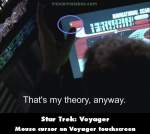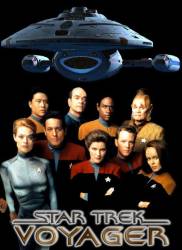Revealing mistake: As Seven starts to explore, there's a flashlight floating next to her. There's no atmosphere, therefore no breeze, but it's slightly moving before she touches it.
Revealing mistake: If you look closely at the hot air balloon, in the shot before the message is attached to it, you can just see a wire holding it up.
Revealing mistake: As Icheb's parents turn their faces towards the sun to look at Icheb, the edges of the prosthetics used for the ridges on their noses are visible.

Revealing mistake: Right at 40:30, if you look in the top left corner of the LCD screen, you can see a mouse cursor. Six seconds later it starts to move around. It seems like someone noticed and tried to move it out of the scene. (00:40:30)






Answer: If you include the original Star Trek series (1966) then there are several. The communicators used in the original series were before (and said to inspire) mobile phones. We currently do have teleportation technology but it currently only works on things the size of a few molecules. A "Cloaking device" also exists; it's a fabric that bends light through it, though it currently only works in infra-red. The Hypospray is real and was patented in 1960 - six years before the original series aired - it's actually called the Jet Injector. Faster Than Light travel is still a few decades off, but there are several real-world theories that look promising, including one that is remarkably similar to the method used in the Star Trek Universe called the Alcubeierre Drive that involves manipulating spacetime ahead and behind the ship and the ship "riding" it. Medical techniques and technologies have also advanced considerably; prosthetics particularity and we routinely have robots performing surgeries where absolute precision is needed. The "Shield" used in the series have a few primitive versions around. The Phasers used in the series are used but are not very powerful (nor will they ever be as powerful as the Star Trek version the laws of physics gets in the way) but rail-guns (using magnets to spin then propel a projectile) and particle accelerators like the Large Hadron Collider have been around for a while. The Replicator would require a nuclear fusion reactor and a nuclear fission reactor in something the size of a large oven and the Holo-deck wouldn't work at all based on our current understanding of physics so those are both still science fiction at the moment, but who knows!
Sanguis